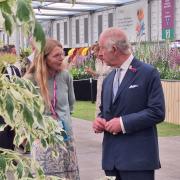It would be easy to pigeonhole Old Court Nurseries and its adjacent Picton Garden as an autumn specialist. True, the family-run nursery holds the National Collection of Michaelmas daisies and is known for a fabulous late summer display yet an early season visit reveals so much more.
The white stems of silver birch gleam in the weak winter sunshine, there are flashes of orange, red and yellow from stands of cornus, while the floor is a mass of jewel-like tiny blooms. It’s clear that when you have a garden run by two skilled horticulturists, they’re unlikely to be constrained to just one season.
Today, the nursery at Colwall, near Ledbury, is run by Helen Picton and her husband Ross Barbour, who took over from Helen’s parents, Paul and Meriel.

Ross had previously worked at Ragley Hall where he created a successful winter garden so when he joined Helen at Picton, he soon had an unused area at the end of the garden in his sights.
‘Paul was winding down and Helen wasn’t expected to come back so the garden was getting planted with shrubs and trees and gradually getting smaller. I spotted it and thought “There’s a nice little space to do to have a bit of fun and create something because there was nothing in it”,’ he recalls.
Pretty soon Ross was out with ‘a box of matches and a chainsaw’ and work on the winter garden began in 2014.
It’s laid out with winding paths that meander under existing trees and around new planting of early performers such as Prunus mume ‘Beni-Chidori’. Pieces of log edge many of the beds although Ross is experimenting with plants, such as Ophiopogon planiscapus ‘Nigrescens’ to create an ‘edge’.
‘The wooden edge is starting to rot so I'm trying to put different things like that to make lines and things, which might work or might not. There's only one way to find out.’
The black foliage also makes the perfect foil for early flowers – ‘It's a cliche and people are snooty about it but you can use it in all sorts of ways.’ – along with the marbled leaves of cyclamen, ferns, and, in a mild winter, foliage from pulmonaria and polypodium.

Luzula sylvatica ‘Auria’ adds splashes of gold, helping to lighten the garden even on grey winter days: ‘It’s a nice bit of colour at this time,’ says Helen, ‘so you can forgive it being scruffy later.’
More much-needed colour and important structure comes from the dogwoods with varieties including ‘Midwinter Fire’, ‘Anny’s Winter Orange’ and ‘Baton Rouge’.
‘All the coloured stems just catch the light so well this time of year and there’s quite a few different colours as well to work with,’ comments Ross.
Even so, he’s not entirely happy about the position of some of them as things such as ‘Kesselringii’, which has a dark, blackcurrant colour, is ‘lost’ in the borders.
There’s scent too from the spidery flowers of beautiful hamamelis in shades of orange and yellow that are carefully planted close to the edge of borders so they can be fully appreciated.

Indeed, unlike many gardens where big borders are important to give a good display, here in the winter garden, Ross has been adding more paths that reduce the depth of the planting space and give more ‘edges’ to place his tiny treasures where they can be admired easily.
‘It also narrows the border so you can see further into it and you can use the middle of it a bit more,’ he explains.
Among the dainty plants that he grows are crocus in shades of mauve, white, yellow and purple, tiny Iris reticulata, Cyclamen coum in pale white and cerise pink, and golden winter aconites (Eranthis hyemalis).
The stars are the couple’s collection of snowdrops, now numbering more than 300 varieties. Before Ross’ arrival, the garden had just a handful.


‘It was stuff that had been left over from my grandfather, but had been sort of neglected,’ recalls Helen.
In contrast, Ross had been collecting for many years – ‘One of the first things I ever gave Helen when we met was a collection of the snowdrops I had.’
Creating the winter garden was as much about finding a home for the snowdrops as it was developing the neglected area.
He’s fond of what he describes as ‘the oldies’ – ‘Some of those that have been around for a long time and will still be around when a lot of the new ones that are being processed at the moment are long gone and forgotten.’
Among them he numbers ‘Magnet’ – ‘It goes back to the dawn of snowdrop time and is robust with a long pedestal. When it lifts, it’s just lovely.’


To the list of ‘favourites’, Helen adds ‘Mrs McNamara’ for its long season, and ‘Trumps’, which bulks up well and is easily identified from a distance.
‘It’s a nice middle-of-the-road snowdrop as well because you feel it’s special but it’s not like you’ve just broken the bank.’
Naturally, given the growing collection, the snowdrops have crept out into the main garden, with more robust varieties planted in the beds that house the Michaelmas daisies. These are normally overflowing with herbaceous, but at this time of year are largely empty, giving long views through the two-acre garden.
Growing herbaceous with winter-flowering bulbs can be tricky and care has to be taken, especially as the couple lift the snowdrops while they’re dormant for chipping or to produce pots for sale.


‘You don’t want the snowdrops that you’re going to need to lift for chipping in the middle of your herbaceous border because you’re not going to find them,’ says Helen. ‘You also don’t want to be digging up herbaceous plants and putting your spade straight through the middle of a clump of some very precious snowdrop.’
So, it tends to be the less precious varieties that are used to add interest to parts of the garden whose moment is later in the year.
Even so, Ross has recently reworked the old rock garden near the entrance, removing big conifers and creating a new path that has resulted in more planting space for snowdrops. No doubt these will soon be joined by other early stars.
The aim of the winter garden, aside from being somewhere to house the snowdrops was, as Ross explains, to create ‘a tapestry on the floor of cyclamen, snowdrops, irises, anything that would flower and look good at this time of year’.
Adding another level of colour with the shrubs and trees has created a truly inspiring celebration of the season.
For opening times and dates, visit the website autumnasters.co.uk
Instagram: @thechattygardener
Facebook: The Chatty Gardener
X: @ChattyGardener





























